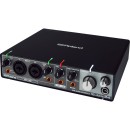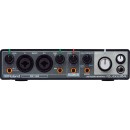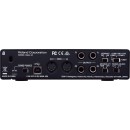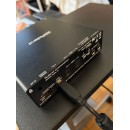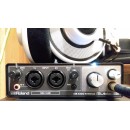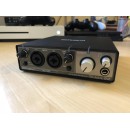Roland Rubix24 Audio Interface Review
- Two high-quality mic preamps with XLR/TRS combo inputs and phantom power.
- 24-bit/192kHz audio fidelity for professional sound quality.
- Low latency, class-compliant drivers for Windows and macOS.
- MIDI in and out ports for connecting external MIDI devices.
- Loopback function for streaming and recording online content.
- Sturdy and compact metal construction for durability and portability.
- Ground lift switch for solving hum and buzz issues.
- Supports USB bus power for easy setup and use on the go.
Specifications, Benefits, and Drawbacks of the Roland Rubix24
The Roland Rubix24 Audio Interface is a high-quality, versatile tool designed for musicians and producers who require reliable and pristine audio recording and playback. Featuring a compact and sturdy design, this interface offers a seamless blend of performance and portability, making it an ideal choice for both studio and mobile recording setups. Built with attention to detail, the Rubix24 ensures clean and transparent sound quality, suitable for a range of musical applications.
Equipped with two high-fidelity mic preamps, the Rubix24 provides a clear and dynamic audio capture, capable of handling a wide range of instruments and vocal recordings. Additionally, it supports up to 24-bit/192kHz audio resolution, which ensures that every nuance of your sound is preserved with exceptional clarity. For added convenience, the interface includes MIDI I/O, allowing seamless integration with other MIDI-enabled devices.
The Rubix24 also features a robust set of connectivity options, including USB connectivity for easy integration with computers and DAWs. It boasts low-latency operation, making it ideal for real-time monitoring and recording. Furthermore, the interface is compatible with Windows, Mac, and iOS devices, providing flexibility and ease of use across different platforms. With its user-friendly design and comprehensive feature set, the Roland Rubix24 is a reliable choice for both amateur and professional audio enthusiasts.
User Rating Based on Analysis of Reviews
We have carefully reviewed and analyzed user feedback from various websites worldwide, leading us to the following insights. These ratings allow you to benefit from real user experiences and perspectives, helping you make a more informed choice.
Purchase Value
85% of users expressed satisfaction with the purchase value of the Roland Rubix24 Audio Interface. They appreciated its competitive pricing compared to other interfaces in the same category, commenting that the features offered were well worth the investment. Many users highlighted the inclusion of high-quality preamps and robust build quality as excellent value for money.
15% of users felt dissatisfied, primarily due to occasional software compatibility issues that they felt were not justified by the price. Some users expected more features for the price point, such as additional input/output options or bundled software, which were available with competitors.
Quality of Materials
88% of users were satisfied with the quality of materials used in the Rubix24 interface. They praised the durable metal chassis, which provided a sense of reliability and longevity. Users also noted that the knobs and switches felt solid and well-made, contributing to a premium feel.
12% of users expressed dissatisfaction, citing that certain plastic components appeared less durable. Some users reported issues with the USB connection becoming loose over time, which they attributed to subpar material quality in that aspect.
Ease of Use
90% of users found the Rubix24 to be user-friendly, especially appreciating its straightforward setup process and intuitive control layout. Many users noted that the interface was quick to integrate into their existing setups, making it accessible even for beginners.
10% of users were dissatisfied, primarily due to initial setup challenges with drivers on certain operating systems. Some users mentioned that the lack of a detailed manual made troubleshooting more difficult than anticipated.
Sound Quality
92% of users were impressed with the sound quality offered by the Rubix24, highlighting the clarity and detail it provided during recording and playback. The preamps were especially praised for their low noise floor and transparency, making the interface a favorite among musicians and podcasters alike.
8% of users expressed dissatisfaction with the sound quality, noting occasional digital artifacts and noise in certain setups. Some users experienced issues with output levels, which they felt affected the overall audio fidelity.
Driver Stability
80% of users were satisfied with the stability of the Rubix24 drivers, finding them reliable across various DAWs and operating systems. Many users appreciated Roland’s commitment to regular updates, which they felt enhanced the interface’s overall performance.
20% of users encountered dissatisfaction, reporting frequent dropouts and crashes, particularly on Windows platforms. Some users mentioned that the updates were not as frequent as needed, leaving them with unresolved issues for extended periods.
Size and Portability
87% of users were pleased with the compact size and portability of the Rubix24, appreciating its lightweight design for easy transport. This made it a popular choice for mobile recording setups, as users could easily carry it between locations.
13% of users were dissatisfied, finding the interface slightly bulkier than expected for a portable device. Some users suggested that a sleeker design with fewer protruding parts would enhance its portability further.
Build Quality
89% of users praised the build quality of the Rubix24, noting its sturdy construction and resistance to wear and tear. The metal casing was frequently highlighted as a strong point, providing both aesthetic appeal and functional durability.
11% of users were dissatisfied, particularly with the quality of the input/output jacks. Some reported that these components felt flimsy and prone to damage, which detracted from the otherwise solid build.
Customer Support
75% of users were satisfied with Roland's customer support, citing helpful and responsive service when seeking assistance. Many users felt that their issues were addressed promptly, enhancing their overall experience with the product.
25% of users were dissatisfied with customer support, reporting long wait times and unhelpful responses. Some users mentioned that their technical problems were not resolved satisfactorily, leading to frustration.
Compatibility with Software
83% of users were satisfied with the Rubix24’s compatibility with a wide range of software, including major DAWs like Ableton Live, Pro Tools, and Logic Pro. Users appreciated the seamless integration and minimal setup required.
17% of users experienced compatibility issues, particularly with lesser-known DAWs or older software versions. Some users reported that certain plugins would not work properly, which limited their workflow options.
Latency Performance
86% of users were satisfied with the latency performance of the Rubix24, noting minimal delay during recording and monitoring. This was especially valued by musicians and live performers who required real-time feedback.
14% of users were dissatisfied with the latency, finding it unsuitable for certain high-demand applications. Some reported that the latency increased significantly when using multiple plugins or tracks, affecting their recording sessions.
Phantom Power Reliability
91% of users expressed satisfaction with the phantom power reliability of the Rubix24, finding it consistently powered their condenser microphones without issue. Users appreciated the clear indication of phantom power status, which minimized accidental misuse.
9% of users were dissatisfied, with some reporting intermittent phantom power delivery, which affected their microphone performance. A few users also mentioned that the phantom power switch was poorly placed, leading to accidental activation.
Aesthetic Design
88% of users appreciated the aesthetic design of the Rubix24, praising its sleek and modern look. Many users felt that the design complemented their studio setups nicely, adding a professional appearance to their workspaces.
12% of users were dissatisfied with the design, feeling that it was too utilitarian and lacked distinctive style. Some users suggested that more color options or customizable elements would improve its visual appeal.
Durability
90% of users lauded the Rubix24 for its durability, noting that it withstood extensive use without showing signs of wear. Users trusted the interface to handle the rigors of frequent transport and setup changes.
10% of users were dissatisfied, primarily due to issues with specific components such as knobs and jacks that became loose over time. A few users experienced cosmetic damage more easily than expected.
Feature Set
84% of users were satisfied with the feature set of the Rubix24, highlighting its versatility for various recording needs. The inclusion of MIDI I/O and multiple input options were frequently commended as useful additions.
16% of users felt that the feature set was lacking, particularly in terms of advanced routing options and onboard effects. Some users were disappointed by the absence of more extensive monitoring controls.
Input/Output Options
82% of users appreciated the input/output options available on the Rubix24, noting that it was sufficient for most home studio setups. They found the dual combo inputs and balanced outputs met their typical recording requirements.
18% of users expressed dissatisfaction, wishing for more input/output options to accommodate larger or more complex setups. Some users noted the lack of a digital output as a limitation for certain applications.
LED Indicators
87% of users were satisfied with the LED indicators on the Rubix24, finding them clear and informative. The indicators were praised for providing quick visual feedback on levels and operational status, which was helpful during recording sessions.
13% of users were dissatisfied, finding the LED indicators too dim or difficult to see in certain lighting conditions. Some users also mentioned that the indicators did not provide enough detailed information about signal levels.
Portability
86% of users valued the portability of the Rubix24, noting its compact size and lightweight design. This made it easy to carry for on-the-go recording sessions, especially for musicians who travel frequently.
14% of users were dissatisfied with the portability, mentioning that the device could be more compact. Some users found that the power and USB cables were cumbersome, detracting from its overall portability.
Setup Process
89% of users found the setup process for the Rubix24 straightforward and quick. They appreciated the plug-and-play nature of the device, which minimized the time needed to start recording.
11% of users were dissatisfied with the setup process, primarily due to initial driver installation issues. Some users encountered difficulties with configuring the interface with their DAWs, which required additional troubleshooting.
Software Bundle
78% of users were satisfied with the software bundle included with the Rubix24, appreciating the introductory DAW and plugin suite that came with the purchase. They felt it provided a good starting point for beginners.
22% of users were dissatisfied, expecting a more comprehensive software bundle. Some users felt that the provided software was too limited in features and did not compare favorably to other interfaces' offerings.
User Manual
76% of users found the user manual helpful, providing clear instructions for basic setup and operation. They appreciated the concise explanations that helped them get started quickly.
24% of users were dissatisfied with the user manual, finding it lacking in depth and detail. Some users expressed a need for more comprehensive troubleshooting guides and advanced feature explanations.
In the following sections, we will delve into the specifications of the Roland Rubix24 Audio Interface, providing a detailed analysis of its features. Additionally, we will discuss the advantages and disadvantages of this product to give you a comprehensive understanding of its performance and capabilities.
Pros:
- High-quality preamps ensure clean and clear audio recording.
- Solid build quality and durable design.
- MIDI I/O capabilities for connecting MIDI devices.
- Compatible with Windows, macOS, and iOS, offering flexibility across platforms.
- Low latency performance enhances real-time monitoring.
- Includes a range of bundled software for music production.
Cons:
- Limited number of input and output channels may not suit advanced setups.
- Some users report driver issues on certain operating systems.
- No digital input/output options like S/PDIF or ADAT.
- Requires external power source, which might limit portability.
General
| Channels of I/O | 2 Input / 4 Output |
|---|---|
| Maximum Sampling Rate | 192 kHz / 24-Bit |
| Number of Microphone Inputs | 2 Preamps |
| Input Level Adjustment | 2x Knob |
| Expansion Slots |
The Channels of I/O specification indicates the number of audio inputs and outputs that the Rubix24 can handle simultaneously. With 2 Input and 4 Output channels, users can connect two microphones or instruments for recording while simultaneously sending audio to external devices such as monitors or effects processors. This flexibility is essential for both studio recordings and live performances, allowing for a more comprehensive audio routing setup.Show More
The Maximum Sampling Rate of 192 kHz at 24-Bit signifies the highest quality of audio that the Rubix24 can process. A higher sampling rate and bit depth allow for more detailed sound reproduction, capturing the nuances of the audio signal with greater clarity. This is particularly important for professional audio work, where fidelity is paramount, making it suitable for recording high-quality music or sound design projects.
Having 2 Microphone Inputs with preamps means that the Rubix24 is equipped to directly connect and amplify two microphones. Preamps are crucial for boosting the microphone signal to a usable level, and having two allows for simultaneous recording of vocals or instruments. This feature is particularly beneficial for duets, interviews, or any scenario where you need to capture multiple sound sources at once.
The Input Level Adjustment with 2x Knob controls allows users to individually set the input gain for each channel. This is essential for optimizing the recording level of different sources, helping to avoid clipping and distortion while ensuring a clean signal. By having dedicated knobs, users can quickly and easily adjust levels in real-time during recording sessions.
Finally, the Expansion Slots specification indicates that the Rubix24 does not support any additional hardware expansions. This means that its capabilities are fixed and users will need to work within the provided features. While this may limit future upgrades, the device is designed to be fully functional out of the box for immediate use in various audio applications.
Connectivity
| Analog Audio I/O | 1x Combo XLR-1/4" TRS Balanced/Unbalanced Mic/Line/Hi-Z Input 1x Combo XLR-1/4" TRS Balanced Mic/Line Input 1x 1/4" TRS Headphone Output 4x 1/4" TRS Balanced Output |
|---|---|
| Phantom Power | 48 V |
| Phantom Power Current | 6 mA (Max) |
| Digital Audio I/O | |
| Host Connection | 1x USB-B |
| Host Connection Protocol | USB 2.0 |
| USB (Non-Host) | 1x Micro-USB (Power Input) |
| MIDI I/O | 1x DIN 5-Pin Input 1x DIN 5-Pin Output |
The Analog Audio I/O section details the various input and output options available on the Roland Rubix24 audio interface. It includes a combination of XLR and TRS (1/4") connectors, allowing users to connect a wide range of audio sources such as microphones, instruments, and line-level devices. The presence of a Hi-Z input is particularly useful for connecting electric guitars or basses directly, ensuring optimal signal capture. Additionally, the four balanced outputs provide flexibility for routing audio to monitors or other devices, while the headphone output allows for private listening and monitoring during recording sessions.Show More
Phantom Power is a crucial feature for using condenser microphones, which require an external power source to operate. The Rubix24 offers 48 V of phantom power, with a maximum current of 6 mA, ensuring compatibility with most condenser mics. This feature allows users to connect high-quality microphones without the need for external power supplies, streamlining the recording process and minimizing setup complexity.
The Digital Audio I/O section indicates that the Rubix24 does not support digital audio input or output, which could limit connectivity with certain digital devices or systems. However, the Host Connection capabilities are robust, featuring a USB-B connection that utilizes USB 2.0 protocol. This connection allows for reliable data transfer between the audio interface and computer, ensuring low latency during recording and playback. Additionally, the inclusion of a Micro-USB port for power input provides versatility in powering the unit from various sources.
Finally, the MIDI I/O section includes a 5-pin DIN input and output, facilitating the connection of MIDI devices such as controllers and synthesizers. This feature enhances the Rubix24's functionality for musicians and producers who wish to integrate MIDI hardware into their setup, allowing for seamless communication between audio and MIDI devices. Overall, these specifications reflect the Rubix24's design as a versatile and user-friendly audio interface for a range of recording and production scenarios.
Performance
| Maximum Input Level | Mic Inputs: +2 dBu Line Inputs: +18 dBu |
|---|---|
| Maximum Output Level | Line Outputs: +8 dBu |
| Headphone Output Power | 20 mW per Channel into 47 Ohms |
| Impedance | Outputs: 2 Kilohms (Balanced) Headphone Outputs: 47 Ohms XLR Mic Inputs: ≥ 4 Kilohms (Balanced) 1/4" Line Inputs: ≥ 15 Kilohms (Balanced) 1/4" Hi-Z Inputs: ≥ 500 Kilohms (Unbalanced) |
| Dynamic Range | A/D Converters: 104 dB D/A Converters: 109 dB |
| SNR | -94 dBu (600-Ohm Load, Min Gain) |
Maximum Input Level refers to the highest audio signal level that the interface can handle without distortion. For the Rubix24, the mic inputs can accommodate signals up to +2 dBu, while the line inputs are rated for +18 dBu. This specification is crucial for ensuring that the audio quality remains pristine, especially when dealing with high-output sources like instruments or professional-grade microphones.Show More
Maximum Output Level indicates the peak signal level that the device can output. The line outputs of the Rubix24 can reach +8 dBu, which is essential for sending strong and clear audio signals to other equipment, such as speakers or mixing consoles, ensuring that there is minimal loss in audio quality.
Headphone Output Power specifies the power output available for driving headphones, listed as 20 mW per channel into 47 Ohms. This is important for users who rely on precise monitoring during recording or mixing sessions, as it allows for adequate volume levels without compromising audio fidelity.
Impedance is a measure of resistance that affects how audio signals are transferred. The Rubix24 features varied impedance levels: 2 Kilohms for outputs, 47 Ohms for headphone outputs, and ≥ 4 Kilohms for XLR mic inputs. This affects compatibility with different audio equipment and can influence the overall sound quality and performance in various setups, particularly when connecting microphones and instruments.
Dynamic Range describes the range between the quietest and loudest sounds that the converters can capture or reproduce. With A/D converters rated at 104 dB and D/A converters at 109 dB, the Rubix24 can handle a wide variety of audio levels, ensuring that both subtle nuances and powerful sounds are accurately represented in recordings.
SNR (Signal-to-Noise Ratio) indicates the level of background noise compared to the level of the desired signal, listed as -94 dBu for a 600-ohm load at minimum gain. A higher SNR means cleaner audio with less unwanted noise, making it a significant factor for achieving high-quality recordings and playback.
Digital Audio
| Sample Rates | 44.1 / 48 / 96 / 192 kHz |
|---|---|
| Bit Depths | 24-Bit |
The Sample Rates of an audio interface refer to the frequency at which audio samples are captured and played back. The Roland Rubix24 offers sample rates of 44.1, 48, 96, and 192 kHz. Higher sample rates, such as 96 and 192 kHz, allow for capturing more detail in the audio signal, which is particularly beneficial in professional audio applications like music production and film scoring. Lower sample rates like 44.1 and 48 kHz are commonly used for standard audio playback and recording, making the interface versatile for various uses.Show More
Bit Depths indicate the range of possible amplitude values for each audio sample, with the Rubix24 supporting a bit depth of 24-Bit. A higher bit depth allows for a greater dynamic range, meaning it can capture softer sounds without distortion and handle louder sounds without clipping. The 24-Bit depth is widely used in professional audio recording, providing high-resolution audio that is essential for producing quality sound in music and other audio projects.
Audio Storage & Playback
| Memory Card Slot |
|---|
The Memory Card Slot feature indicates whether the Roland Rubix24 Audio Interface is equipped with a slot for an external memory card. In this case, the absence of a memory card slot means that users cannot expand the device's storage capacity by inserting a memory card. This might limit the device's ability to store large audio files or projects directly on the interface, requiring users to rely on their computer or other external storage solutions for managing audio data.Show More
Having a memory card slot can be beneficial for musicians and audio professionals who prefer to record directly onto a card for easier transport and backup. However, the Rubix24's design focuses on streamlined connectivity and performance, suggesting that it is optimized for real-time processing and integration with a computer-based setup rather than standalone recording capabilities. Users should consider their workflow and storage needs when evaluating the significance of this feature.
Compatibility
| OS Compatibility | Windows 7 Windows 8 Windows 8.1 Windows 10 macOS 10.10 or Later iPadOS 9 or Later |
|---|---|
| Included Software | |
| Mobile Device Compatibility | iPad iPhone |
OS Compatibility refers to the operating systems that can support the Roland Rubix24 Audio Interface. This feature is crucial for users as it determines whether the device can be used with their current computer or mobile setup. With compatibility for a range of Windows versions, from Windows 7 to Windows 10, as well as macOS from version 10.10 onward, along with iPadOS 9 and later, users have the flexibility to connect the interface to various devices. This broad compatibility ensures that both laptop and desktop users can take advantage of the Rubix24's features, enhancing its versatility in different environments.Show More
Included Software indicates whether the Roland Rubix24 comes with bundled software for music production or audio manipulation. In this case, the specification states "No," meaning the device does not include any proprietary software. While this may seem limiting, many users often prefer to use their own preferred Digital Audio Workstations (DAWs) and plugins, which allows for a more customized audio production experience. The absence of included software can also lower the overall cost of the interface, making it an attractive option for those who already have their tools in place.
Mobile Device Compatibility highlights the ability of the Rubix24 to connect with mobile devices, specifically iPads and iPhones. This feature is significant for users who wish to use the audio interface for mobile recording or live performances. The convenience of being able to connect to mobile devices expands the functionality of the Rubix24, allowing musicians and audio engineers to create and edit music on-the-go. This compatibility makes it a flexible choice for those who want to integrate their mobile devices into their audio workflow.
Power
| Power Requirements | USB Bus Power |
|---|---|
| Current Consumption | 500 mA |
The Power Requirements specification indicates how the Roland Rubix24 Audio Interface is powered. This particular model utilizes USB Bus Power, meaning it draws power directly from the computer it's connected to via USB. This is a convenient feature for users who prefer a tidy setup without the need for additional power adapters or outlets, making it an ideal choice for mobile recording or smaller studio environments.Show More
The Current Consumption value of 500 mA reflects the amount of electrical current the device requires to operate effectively. This specification is important because it informs users about the power needs of the interface, ensuring that the USB port it connects to can supply sufficient current. In most cases, standard USB ports on computers can easily provide this level of current, ensuring reliable performance without the risk of power shortages that could affect functionality.
Physical
| Dimensions | 7.2 x 6.5 x 1.8" / 18.3 x 16.5 x 4.6 cm |
|---|---|
| Weight | 2.6 lb / 1.2 kg |
The Dimensions of the Roland Rubix24 Audio Interface are 7.2 x 6.5 x 1.8 inches, which translates to 18.3 x 16.5 x 4.6 centimeters. These measurements indicate a compact and portable design, making it easy to fit into a studio setup or transport for mobile recording. The relatively small footprint is ideal for users who need to optimize space without sacrificing functionality.Show More
In terms of Weight, the Rubix24 weighs 2.6 pounds (or 1.2 kilograms). This lightweight design enhances portability, allowing musicians and audio professionals to carry the device with ease. Whether you're working in a home studio or on location, the manageable weight ensures that the interface can be quickly set up and stored away, contributing to a seamless workflow.
Packaging Info
| Package Weight | 3.9 lb |
|---|---|
| Box Dimensions (LxWxH) | 10.8 x 8.9 x 3.4" |
Package Weight: The package weight of 3.9 lb indicates the total weight of the Roland Rubix24 Audio Interface when it is packaged for shipment. This weight is important for users to consider, especially when factoring in shipping costs and handling. A lighter weight can make transportation easier, while a heavier unit may require more robust shipping methods. Overall, the weight can also suggest the build quality and durability of the interface.Show More
Box Dimensions (LxWxH): The dimensions of the box, which measure 10.8 x 8.9 x 3.4 inches, provide insight into the overall size of the packaging. This information is useful for users who need to consider space for storage or transportation. A compact design can be advantageous for portability, allowing for easier setup in various environments, whether in a studio or on the go. Additionally, understanding the box dimensions can help users ensure they have adequate space during unboxing and installation.
Customer Images
Customer Questions
How do I connect the Roland Rubix24 to my computer?
To connect the Roland Rubix24 to your computer, use the included USB cable. Connect one end to the USB port on the Rubix24 and the other to a USB port on your computer. Make sure the Rubix24 is powered on.
Why is there no sound coming from my speakers when using the Rubix24?
Ensure that the Rubix24 is selected as the audio output device in your computer's sound settings. Also, check that the volume on the Rubix24 and your speakers is turned up and that all cables are securely connected.
What drivers do I need to install for the Rubix24?
Visit the Roland website to download the latest Rubix24 drivers for your operating system. Install them following the provided instructions to ensure compatibility and optimal performance.
How can I reduce latency when recording with the Rubix24?
To reduce latency, adjust the buffer size in your DAW's audio settings. Lower buffer sizes reduce latency but may increase CPU load. Experiment to find the best balance for your system.
Why is my microphone input not being detected on the Rubix24?
Ensure your microphone is properly connected to the correct input channel and that phantom power is enabled if using a condenser microphone. Check that the input gain is set to an appropriate level.
How do I update the firmware on my Rubix24?
Download the latest firmware from the Roland website. Follow the instructions provided in the download package to update your Rubix24 via USB connection.
Can the Rubix24 be used with an iPad?
Yes, the Rubix24 can be used with an iPad. You'll need a compatible USB camera adapter and a power source for the Rubix24, as it cannot be powered by the iPad.
Why am I experiencing audio dropouts during playback?
Audio dropouts can occur due to high CPU usage or low buffer size settings. Adjust the buffer size in your DAW and close unnecessary programs to free up system resources.
How do I set up direct monitoring on the Rubix24?
Use the Mix knob on the front panel of the Rubix24 to blend the input signal with the playback signal for direct monitoring without latency.
What should I do if the Rubix24 is not recognized by my DAW?
Ensure that the Rubix24 is properly connected and powered on. Check that the correct drivers are installed and that the Rubix24 is selected as the audio interface in your DAW's audio settings.
